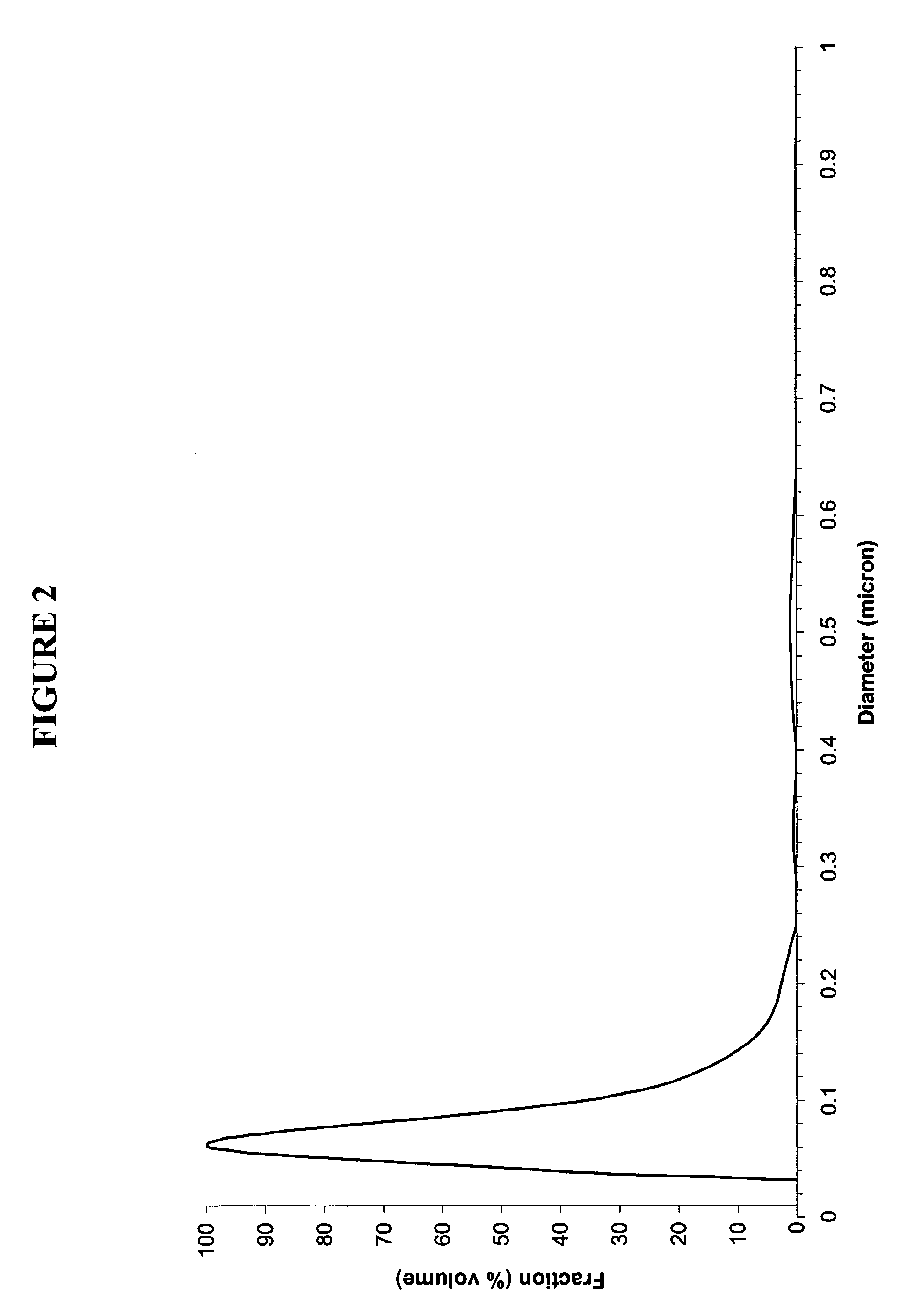Production Of Barium Titanate Compounds
a technology of barium titanate and compound, which is applied in the direction of nickel compounds, inorganic chemistry, alkali metal oxides/hydroxides, etc., can solve the problems of large agglomerates larger than the thickness of the dielectric layer of the mlcc, affecting the obtaining of adequate mlcc, and large particle size, and achieves low cost and high purity.
- Summary
- Abstract
- Description
- Claims
- Application Information
AI Technical Summary
Benefits of technology
Problems solved by technology
Method used
Image
Examples
example 1a
[0114] To prepare 1 kg of cubic-phase barium titanate with a volume median size (dv50) of 75 nm detemined by sedimentation, twelve litres of gel were prepared at ambient temperature by mixing 6 litres of a NaOH solution at a concentration of 4.42 mol / kg and 6 litres of BaCl2 and TiCl4 solution at a concentration of 0.561 mol / kg and 0.550 mol / kg respectively. The gel was fed to a Segmented Flow Tubular Reactor comprising a tube immersed in a water bath maintained at 98° C. A heating time from room temperature to 98° C. within less than 20 seconds was ensured. The residence time of the gel in the tube was between 3 to 5 minutes, over the 2 minutes reaction time required to transform the gel into a suspension of barium titanate nanoparticles at this temperature. The suspension was collected at the outlet of the tube in a vessel maintained at room temperature. The suspension was then allowed to decant for 2 hours and about 10 litres of supernatant were removed from the storage vessel. T...
example 1b
[0116] To prepare 1 kg of cubic-phase barium titanate with a volume median size (dv50) of 155 nm detemined by sedimentation, in a variation of Example 1a, twelve litres of gel were prepared at ambient temperature by mixing 6 litres of a NaOH solution at a concentration of 1.6 mol / kg and 6 litres of BaCl2 and TiCl4 solution at a concentration of 0.22 mol / kg and 0.20 mol / kg respectively. The gel was fed to a Segmented Flow Tubular Reactor comprising a tube immersed in a water bath maintained at 87° C. A heating time from room temperature to 87° C. within less than 20 seconds was ensured. The residence time of the gel in the tube was between 8 to 10 minutes, over the time (about 3-4 minutes) required to transform the gel into a suspension of barium titanate nanoparticles at this temperature. The suspension was collected at the outlet of the tube in a vessel maintained at room temperature. The suspension was then allowed to decant for 2 hours and about 10 litres of supernatant were remo...
example 2
mal Post-Treatment
[0119] The hydrothermal post-treatment was carried out by mixing 2 g of barium titanate produced according to procedure described in Example 1a with 30 g of a Ba(OH)2 solution. This solution was initially prepared by dissolving 16.7 g of Ba(OH)2 in 1 litre of water. The suspension was placed in a 40 ml hydrothermal autoclave, itself placed in an oven heated at 250° C. Reaching a temperature of 250° C. inside the autoclave required 1 hour, the autoclave was then allowed to stay at this temperature for 1 hour and then to cool naturally to room temperature. The suspension was recovered and the supernatant was removed. The powder washed in several steps and then dried. The powder was then characterized.
[0120] As presented in Table 1, the volume particle size distribution determined by sedimentation shows dv50 of 106 nm with a dv10 and dv90 of 71 nm and 15 μm respectively without any agglomerate above 250 nm. Image analysis has been carried out in order to define numbe...
PUM
| Property | Measurement | Unit |
|---|---|---|
| particle size distribution | aaaaa | aaaaa |
| boiling temperature | aaaaa | aaaaa |
| temperatures | aaaaa | aaaaa |
Abstract
Description
Claims
Application Information
 Login to View More
Login to View More - R&D
- Intellectual Property
- Life Sciences
- Materials
- Tech Scout
- Unparalleled Data Quality
- Higher Quality Content
- 60% Fewer Hallucinations
Browse by: Latest US Patents, China's latest patents, Technical Efficacy Thesaurus, Application Domain, Technology Topic, Popular Technical Reports.
© 2025 PatSnap. All rights reserved.Legal|Privacy policy|Modern Slavery Act Transparency Statement|Sitemap|About US| Contact US: help@patsnap.com



